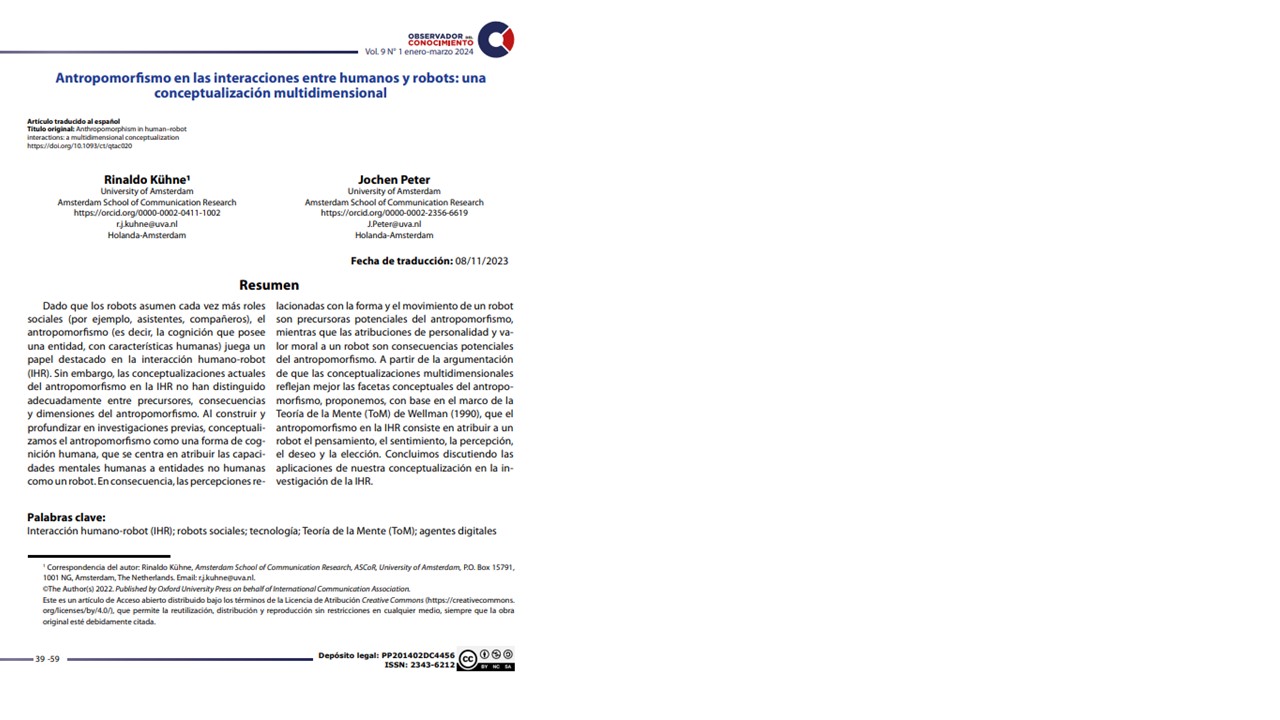Antropomorfismo en las interacciones entre humanos y robots: una conceptualización multidimensional
Palabras clave:
Interacción humano-robot (IHR), robots sociales, tecnología, Teoría de la Mente (ToM), agentes digitalesResumen
Dado que los robots asumen cada vez más roles sociales (por ejemplo, asistentes, compañeros), el antropomorfismo (es decir, la cognición que posee una entidad, con características humanas) juega un papel destacado en la interacción humano-robot (IHR). Sin embargo, las conceptualizaciones actuales del antropomorfismo en la IHR no han distinguido adecuadamente entre precursores, consecuencias y dimensiones del antropomorfismo. Al construir y profundizar en investigaciones previas, conceptualizamos el antropomorfismo como una forma de cognición humana, que se centra en atribuir las capacidades mentales humanas a entidades no humanas como un robot.
Descargas
Citas
Airenti, G. (2018). The development of anthropomor- phism in interaction: Intersubjectivity, imagination, and theory of mind. Frontiers in Psychology, 9, 2136. https:// doi.org/10.3389/fpsyg.2018.02136
Banks, J. (2020). Theory of mind in social robots: Re- plication of five established human tests. International Journal of Social Robotics, 12(2), 403–414. https://doi. org/10.1007/s12369-019-00588-x
Barco, A.; de Jong, C.; Peter, J., Kühne, R. y van Stra- ten, C. L. (2020). Robot morphology and children’s per- ception of social robots. An exploratory study. In Compa- nion of the 2020 ACM/IEEEInternational Conference on Human-Robot Interaction (pp. 125–127). https://doi. org/10.1145/3371382.3378348
Bartneck, C.; Kuli, D.; Croft, E. y Zoghbi, S. (2009). Mea- surement instruments for the anthropomorphism, ani- macy, likeability, perceived intelligence, and perceived safety of robots. International Journal of Social Robotics, 1(1), 71–81. https://doi.org/10.1007/s12369-008-0001-3
Baumeister, R. (2016). Toward a general theory of mo- tivation: Problems, challenges, opportunities, and the big picture. Motivation and Emotion, 40(1), 1–10. https://doi. org/10.1007/s11031-015-9521-y
Beer, J.; Fisk, A. y Rogers, W. (2014). Toward a fra- mework for levels of robot autonomy in human-robot interaction. Journal of Human–Robot Interaction, 3(2), 74–99. https://doi.org/10.5898/JHRI.3.2.Beer
Benninghoff, B., Kulms, P., Hoffmann, L. y Krämer, N. (2013). Theory of mind in human–robot-communication: Appreciated or not? https://doi.org/10.17185/DUEPUBLI- CO/31357
Bigman, Y., Waytz, A.; Alterovitz, R. y Gray, K. (2019). Holding robots responsible: The elements of machine mo- rality. Trends in Cognitive Sciences, 23(5), 365–368. ht- tps://doi.org/10.1016/j.tics.2019.02.008
Biocca, F.; Harms, C. y Burgoon, J. (2003). Toward a more robust theory and measure of social presence: Re- view and suggested criteria. Presence: Teleoperators and Virtual Environments, 12(5),456–480. https://doi. org/10.1162/105474603322761270
Bjorklund, D. y Causey, K. (2018). Children’s thinking.
Cognitive development and individual differences. Sage.
Blanchette, I. y Richards, A. (2010). The influence of affect on higher level cognition: A review of research on interpretation, judgment, decision making and reaso- ning. Cognition & Emotion, 24(4), 561–595. https://doi. org/10.1080/02699930903132496
Breazeal, C. (2003). Toward sociable robots. Robotics and Autonomous Systems, 42(3–4), 167–175. https://doi. org/10.1016/S0921-8890(02)00373-1
Broadbent, E. (2017). Interactions with robots: The truths we reveal about ourselves. Annual Review of Psy- chology, 68(1), 627–652. https://doi.org/10.1146/annu- rev-psych-010416-043958
Coltman, T.; Devinney, T.; Midgley, D. y Venaik, S. (2008). Formative versus reflective measurement models: Two applications of formative measurement. Journal of Business Research, 61(12), 1250–1262. https://doi.or- g/10.1016/j.jbusres.2008.01.013
De Jong, C.; Peter, J.; Kühne, R. y Barco, A. (2019). Chil- dren’s acceptance of social robots: A narrative review of the research 2000–2017. Interaction Studies. Social Behaviour and Communication in Biological and Artificial Systems, 20(3), 393–425. https://doi.org/10.1075/is.18071.jon
Dennett, D. (1987). The intentional stance. MIT Press. Dennett, D. (1988). Conditions of personhood. En M. F.
Goodman (ed.), What is a person? (pp. 145–167). Humana Press. https://doi.org/10.1007/978-1-4612-3950-5_7
Duffy, B. (2003). Anthropomorphism and the social robot. Robotics and Autonomous Systems, 42(3-4), 177–
https://doi.org/10.1016/S0921-8890(02)00374-3
Echterhoff, G.; Bohner, G. y Siebler, F. (2006). Social Robotics und Mensch-Maschine-Interaktion [“Social Ro- botics” and human-machine-interaction]. Zeitschrift für Sozialpsychologie, 37(4),219–231. https://doi. org/10.1024/0044-3514.37.4.219
Epley, N. (2018). A mind like mine: The exceptionally ordinary underpinnings of anthropomorphism. Journal of the Association for Consumer Research, 3(4), 591–598. https://doi.org/10.1086/699516
Epley, N. y Waytz, A. (2010). Mind perception. En S. T. Fiske, D. T. Gilbert y G. Lindzey (eds.), The handbook of so- cial psychology (5° ed., pp. 498–541). Wiley.
Epley, N.; Waytz, A. y Cacioppo, J.(2007). On see- ing human: A three-factor theory of anthropomorphism. Psychological Review, 114(4), 864–886. https://doi.or- g/10.1037/0033-295X.114.4.864
Eyssel, F. (2017). An experimental psychological pers- pective on social robotics. Robotics and Autonomous Systems, 87, 363–371. https://doi.org/10.1016/j.ro- bot.2016.08.029
Eyssel, F.; Hegel, F.; Horstmann, G. y Wagner, C. (2010). Anthropomorphic inferences from emotional nonverbal cues: A case study. En 19th International Symposium in Robot and Human Interactive Communication (pp. 646– 651). https://doi.org/10.1109/ROMAN.2010.5598687
Eyssel, F.; Kuchenbrandt, D. y Bobinger, S. (2011). Effects of anticipated human–robot interaction and predic- tability of robot behavior on perceptions of anthropomor- phism. En Proceedings of the 6th International Conferen- ce on Human–Robot Interaction - IHR ’11 (p. 61). https:// doi.org/10.1145/1957656.1957673
Ferrari, F.; Paladino, M. y Jetten, J. (2016). Blurring hu- manmachine distinctions: Anthropomorphic appearance in social robots as a threat to human distinctiveness. Inter- national Journal of Social Robotics, 8(2), 287–302. https:// doi.org/10.1007/s12369-016-0338-y
Fink, J. (2012). Anthropomorphism and human likeness in the design of robots and human–robot interaction. En S. S. Ge, O. Khatib, J.-J. Cabibihan, R. Simmons y M.-A. Williams (eds.), Social robotics. 4° International Conference, ICSR 2012, Chengdu, China, October 29-31, 2012, Proceedings (pp. 199–208). Springer. https://doi.org/10.1007/978-3- 642-34103-8_20
Fong, T. ; Nourbakhsh, I. y Dautenhahn, K. (2003). A survey of socially interactive robots. Robotics and Autono- mous Systems, 42(3–4), 143–166. https://doi.org/10.1016/ S0921-8890(02)00372-X
Fraune, M. (2020). Our robots, our team: Robot an- thropomorphism moderates group effects in human–ro- bot teams. Frontiers in Psychology, 11, 1275. https://doi. org/10.3389/fpsyg.2020.01275
Fraune, M.; Oisted, B.; Sembrowski, C.; Gates, K.; Krupp,
M. y Sabanovic, S. (2020). Effects of robot–human versus ro- bot–robot behavior and entitativity on anthropomorphism and willingness to interact. Computers in Human Behavior, 105, 106220. https://doi.org/10.1016/j.chb.2019.106220
Fussell, S.; Kiesler, S.; Setlock, L. y Yew, V. (2008). How people anthropomorphize robots. En Procee- dings of the 3° International Conference on Hu- man Robot Interaction - IHR’08 (p. 145). https://doi. org/10.1145/1349822.1349842
Gong, L. (2008). How social is social responses to com- puters? The function of the degree of anthropomorphism in computer representations. Computers in Human Be- havior, 24(4), 1494–1509. https://doi.org/10.1016/j. chb.2007.05.007
Gray, H.; Gray, K. y Wegner, D. (2007). Dimensions of mind perception. Science (New York, N.Y.), 315(5812), 619– 619. https://doi.org/10.1126/science.1134475
Gunkel, D. (2012). The machine question. Critical pers- pectives on AI, robots, and ethics. MIT Press.
Gunkel, D. (2022). The symptom of ethics: Rethinking ethics in the face of the machine. Human-Machine Com- munication, 4, 67–83. https://doi.org/10.30658/hmc.4.4
Guzman, A. (2018). What is human–machine commu- nication, anyway? En A. L. Guzman (ed.), Human-machine communication: Rethinking communication, technolo- gy, and ourselves (pp. 1–28). Peter Lang.
Haslam, N. (2006). Dehumanization: An integrative review. Personality and Social. Psychology Review: An Official Journal of the Society forPersonality and Social Psychology, Inc, 10(3), 252–264. https://doi.org/10.1207/ s15327957pspr1003_4
Haslam, N. y Loughnan, S. (2014). Dehumaniza- tion and infrahumanization. Annual Review of Psycho- logy, 65(1), 399–423. https://doi.org/10.1146/annu- rev-psych-010213-115045
Haslam, N.; Loughnan, S.; Kashima, Y. y Bain, P. (2009). Attributing and denying humanness to others. European Review of Social Psychology, 19(1), 55–85. https://doi. org/10.1080/10463280801981645
Hegel, F.; Krach, S.; Kircher, T.; Wrede, B. y Sagerer, G. (2008). Understanding social robots: A user study on an- thropomorphism. En RO-MAN 2008 - The 17th IEEE Inter- national Symposium on Robot and Human Interactive Communication (pp. 574–579). https://doi.org/10.1109/ ROMAN.2008.4600728
Higgins, E. (1990). Personality, social psychology, and person situation relations: Standards and knowledge acti- vation as a common language. En L. A. Pervin (ed.), Hand- book of personality: Theory and research. (pp. 301–338). The Guilford Press.
Himma, K. (2009). Artificial agency, consciousness, and the criteria for moral agency: What properties must an artificial agent have to be a moral agent? Ethics and Information Technology, 11(1), 19–29. https://doi. org/10.1007/s10676-008-9167-5
Ho, C. y MacDorman, K. (2010). Revisiting the uncanny valley theory: Developing and validating an alternative to the Godspeed indices. Computers in Human Behavior, 26(6), 1508–1518. https://doi.org/10.1016/j.chb.2010.05.015
Hortensius, R. y Cross, E. (2018). From automata to animate beings: The scope and limits of attributing social- ness to artificial agents. Annals of the New York Academy of Sciences, 1426(1),93–110. https://doi.org/10.1111/ nyas.13727
Hubbard, F. (2011). “Do androids dream?”: Personhood and intelligent artifacts. Temple Law Review, 83(2), 405–
https://ssrn.com/abstract1⁄41725983
Kahn, P.; Ishiguro, H.; Friedman, B.; Kanda, T.; Freier, N.; Severson, R. y Miller, J. (2007). What is a Human?: Toward psychological benchmarks in the field of human–robot. In- teraction Studies. Social Behaviour and Communication in Biological and Artificial Systems, 8(3), 363–390. https://doi. org/10.1075/is.8.3.04kah
Kiesler, S. y Goetz, J. (2002). Mental models of robo- tic assistants. En CHI ’02 Extended Abstracts on Human Factors in Computing Systems - CHI ’02 (pp. 576–577). ht- tps://doi.org/10.1145/506443.506491
Kiesler, S.; Powers, A.; Fussell, S. y Torrey, C. (2008). Anthropomorphic interactions with a robot and robot-li- ke agent. Social Cognition, 26(2), 169–181. https://doi. org/10.1521/soco.2008.26.2.169
Kim, Y. y Sundar, S. (2012). Anthropomorphism of computers: Is it mindful or mindless? Computers in Hu- man Behavior, 28(1), 241–250. https://doi.org/10.1016/j. chb.2011.09.006
Krausová, A. y Hazan, H. (2013). Creating free will in artificial intelligence. En J. Romportl, P. Ircing, E. Zackova, M. Polak y R. Schuster (eds.), Beyond AI: Artificial golem intelli- gence. Proceedings of the International Conference Beyond AI 2013 (pp. 96–109). University of West Bohemia.
LeDoux, J. (1999). The emotional brain: The mysterious underpinnings of emotional life. Phoenix.
Lee-Won, R.; Joo, Y. y Park, S. (2020). Media equa- tion. En J. Bulck (ed.), The International Encyclopedia of Media Psychology (1° ed., pp. 1–10). Wiley. https://doi. org/10.1002/9781119011071.iemp0158
Lemaignan, S.; Fink, J.; Dillenbourg, P. y Braboszcz,
C. (2014). The cognitive correlates of anthropomorphism. En 2014 Human–Robot Interaction Conference, Workshop “HRI: A bridge between Robotics and Neuroscience.”
Leventhal, H. y Scherer, K. (1987). The relationship of emotion to cognition: A functional approach to a semantic controversy. Cognition & Emotion, 1(1), 3–28. https://doi. org/10.1080/02699938708408361
Liarokapis, M.; Artemiadis, P. y Kyriakopoulos, K. (2013). Quantifying anthropomorphism of robot hands. En 2013 IEEE International Conference on Robo- tics and Automation (pp. 2041–2046). https://doi.or- g/10.1109ICRA.2013.6630850
Lombard, M. y Xu, K. (2021). Social Responses to Me- dia Technologies in the 21st Century: The Media are Social Actors Paradigm. Human-Machine Communication, 2, 29–55. https://doi.org/10.30658/hmc.2.2
Margolin, D. (2021). The theory of informative fictions: A character-based approach to false news and other misinfor- mation. Communication Theory, 31(4), 714–736. https:// doi.org/10.1093/ct/qtaa002
McLeod, J. y Pan, Z. (2005). Concept explication and theory construction. En S. Dunwoody, L. B. Becker, D. M. McLeod y G. M. Kosicki (eds.), The evolution of key mass communication concepts: Honoring Jack M. McLeod. (pp. 13–76). Hampton Press.
Morewedge, C.; Preston, J. y Wegner, D. (2007). Ti- mescale bias in the attribution of mind. Journal of Perso- nality and Social Psychology, 93(1), 1–11. https://doi. org/10.1037/0022-3514.93.1.1
Nass, C. y Moon, Y. (2000). Machines and mindlessness: Social responses to computers. Journal of Social Issues, 56(1), 81–103. https://doi.org/10.1111/0022-4537.00153
Ruijten, P. (2018). Perceptions of human-likeness in hu- man–robot interaction research. Unpublished manuscript.
Ryan, R. y Deci, E. (2000). Self-determination theory and the facilitation of intrinsic motivation, social development, and well-being. The American Psychologist, 55(1), 68–78. https://doi.org/10.1037/0003-066X.55.1.68
Salem, M.; Eyssel, F.; Rohlfing, K., Kopp, S. y Joublin,
F. (2013). To err is human(-like): Effects of robot gesture on perceived anthropomorphism and likability. Internatio- nal Journal of Social Robotics, 5(3), 313–323. https://doi. org/10.1007/s12369-013-0196-9
Scassellati, B. (2002). Theory of mind for a humanoid robot. Autonomous Robots, 12(1), 13–24. https://doi.or- g/10.1023/A:1013298507114
Scholl, B. y Tremoulet, P. (2000). Perceptual causality and animacy. Trends in Cognitive Sciences, 4(8), 299–309. https://doi.org/10.1016/S1364-6613(00)01506-0
Schroeder, J. y Epley, N. (2016). Mistaking minds and machines: How speech affects dehumanization and an- thropomorphism. Journal of Experimental Psychology. General, 145(11), 1427–1437. https://doi.org/10.1037/ xge0000214
Smith, E. y De Coster, J. (2000). Dual-process models in social and cognitive psychology: Conceptual integration and links to underlying memory systems. Personality and Social Psychology Review, 4(2), 108–131. https://doi. org/10.1207/S15327957PSPR0402_01
Stafford, R.; MacDonald, B.; Jayawardena, C.; Wegner,
D. y Broadbent, E. (2014). Does the robot have a mind? Mind perception and attitudes towards robots predict use of an eldercare robot. International Journal of Social Ro- botics, 6(1), 17–32. https://doi.org/10.1007/s12369-013- 0186-y
Sullins, J. (2006). When is a robot a moral agent? Inter- national Review of Information Ethics, 6, 23–30. doi: ht- tps://doi.org/10.29173/irie136
Tan, H., Wang, D. y Sabanovic, S. (2018). Projecting life onto robots:The effects of cultural factors and design type on multi-Level evaluations of robot anthropomorphism. En 2018 27th IEEE International Symposium on Robot and Human Interactive Communication (RO-MAN) (pp. 129– 136). https://doi.org/10.1109/ROMAN.2018.8525584
Trovato, G. y Eyssel, F. (2017). Mind attribution to an- droids: A comparative study with Italian and Japanese adolescents. En 2017 26th IEEE International Sympo- sium on Robot and Human Interactive Communication (RO-MAN) (pp. 561–566). https://doi.org/10.1109/RO- MAN.2017.8172358
Urquiza-Haas, E. y Kotrschal, K. (2015). The mind be- hind anthropomorphic thinking: Attribution of mental sta- tes to other species. Animal Behaviour, 109, 167–176. ht- tps://doi.org/10.1016/j.anbehav.2015.08.011
Wang, X. y Krumhuber, E. (2018). Mind perception of robots varies with their economic versus social function. Frontiers in Psychology, 9, 1230. https://doi.org/10.3389/ fpsyg.2018.01230
Waytz, A.; Epley, N. y Cacioppo, J. (2010). So- cial cognition unbound: Insights into anthropomor- phism and dehumanization. Current Directions in Psychological Science, 19(1), 58–62. https://doi. org/10.1177/0963721409359302
Waytz, A.; Gray, K.; Epley, N. y Wegner, D. M. (2010). Cau- ses and consequences of mind perception. Trends in Cogni- tive Sciences, 14(8), 383–388. https://doi.org/10.1016/j. tics.2010.05.006
Waytz, A.; Morewedge, C.; Epley, N.; Monteleone, G.; Gao, J. y Cacioppo, J. (2010). Making sense by making sentient: Effectance motivation increases anthropo- morphism. Journal of Personality and Social Psychology, 99(3), 410–435. https://doi.org/10.1037/a0020240
Wellman, H. (1990). The child’s theory of mind. MIT Press.
Wellman, H. y Bartsch, K. (1988). Young children’s rea- soning about beliefs. Cognition, 30(3), 239–277. https:// doi.org/10.1016/0010-0277(88)90021-2
Westermann, R. (2000). Wissenschaftstheorie und Experimentalmethodik: Ein Lehrbuch zur Psycholo- gischen Methodenlehre [Philosophy of science and experimental methods: A textbook on psychological methdology]. Hogrefe.
Yogeeswaran, K.; Złotowski, J.; Livingstone, M.; Bart- neck, C.; Sumioka, H. y Ishiguro, H. (2016). The interactive effects of robot anthropomorphism and robot ability on perceived threat and support for robotics research. Jour- nal of Human–Robot Interaction, 5(2), 29. https://doi. org/10.5898/JHRI.5.2.Yogeeswaran
Zhang, T.; Zhu, B.; Lee, L. y Kaber, D. (2008). Service ro- bot anthropomorphism and interface design for emotion in human–robot interaction. En 2008 IEEE International Conference on Automation Science and Engineering (pp. 674–679). https://doi.org/10.1109/COASE.2008.4626532
Złotowski, J.; Proudfoot, D.; Yogeeswaran, K. y Bart- neck, C. (2015). Anthropomorphism: Opportunities and challenges in human–robotinteraction. International Journal of Social Robotics, 7(3), 347–360. https://doi. org/10.1007/s12369-014-0267-6
Złotowski, J.; Strasser, E. y Bartneck, C. (2014). Dimensions of anthropomorphism: From humanness tohumanlikeness. En Proceedings of the 2014 ACM/IEEE International Confe- rence on Human–Robot Interaction - IHR ’14 (pp. 66–73). ht- tps://doi.org/10.1145/2559636.2559679

Descargas
Publicado
Cómo citar
Número
Sección
Licencia

Esta obra está bajo una licencia internacional Creative Commons Atribución-SinDerivadas 4.0.







